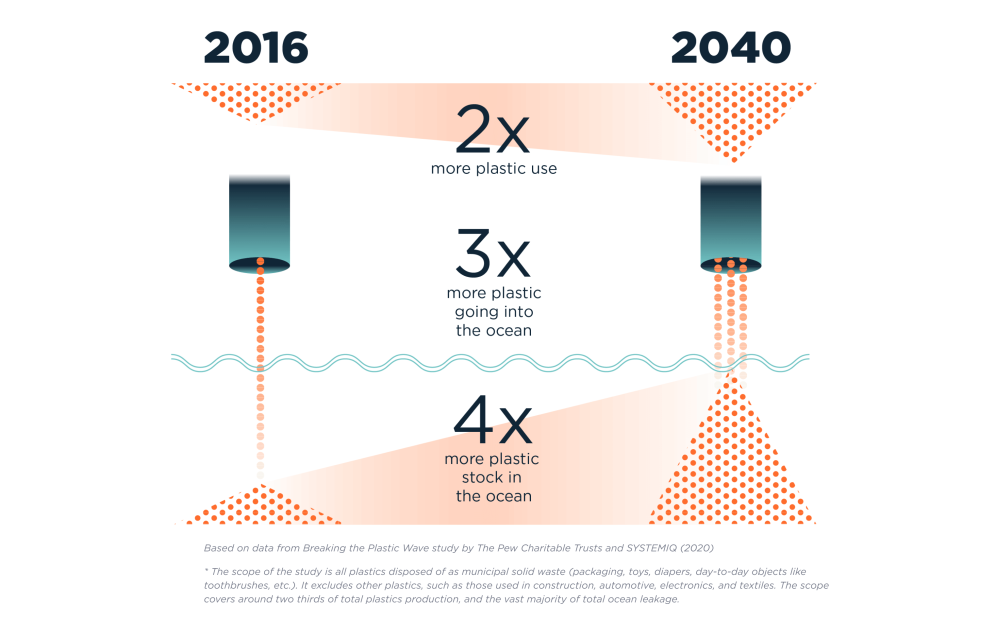On the 23rd of July 2020, The Pew Charitable Trusts and SYSTEMIQ released Breaking the Plastic Wave: A Comprehensive Assessment of Pathways Towards Stopping Ocean Plastic Pollution - one of the most analytically robust studies ever produced on ocean plastics. Thought partners were the University of Oxford, University of Leeds, Common Seas, and the Ellen MacArthur Foundation. This is our perspective on the study’s findings and what businesses and governments must do now to address them.
“We need to raise our level of ambition and match it with bold and urgent action.”
Dame Ellen MacArthur
Failure to act now will see ocean plastic stocks quadruple by 2040
Breaking the Plastic Wave shows that, if we fail to act, by 2040:
the volume of plastic on the market will double
the annual volume of plastic entering the ocean will almost triple, from 11m tonnes in 2016 to 29m tonnes in 2040
ocean plastic stocks will quadruple, reaching over 600m tonnes
This is in line with our 2016 analysis, which showed there could be more plastic than fish in the ocean by 2050.

The solutions lie in a circular economy
The problem starts long before plastic reaches our oceans and so must the solutions.
Until now, many efforts to tackle plastic pollution have focused narrowly on improving waste management or clean-ups. Others have focused only on bans and plastic reduction. None of these will work in isolation. We cannot recyclerecycleTransform a product or component into its basic materials or substances and reprocessing them into new materials. our way out of plastic pollution, and neither can we simply reduce our way out of it.
Breaking the Plastic Wave shows that we must take a comprehensive circular economy approach. We must prioritise rethinking what is put on the market, whilst also rapidly increasing our ability to keep it in the loop after it has been used.
We won't recycle or dispose our way out of plastic pollution
Scenarios focused on collection, recycling and disposal alone fall short

Limited by speed of infrastructure development
Scaling collection, recycling and disposal is limited by the realistic speed of infrastructure development, esp. in the Global South. Connecting everyone to formal collection systems would require connecting over 500,000 people every single day between today and 2040.

High annual leakage of plastics in the ocean
These scenarios fail to reduce the annual amount of plastics entering our oceans in 2040 below 2016 levels, even with the most aggressive, but realistic pace of infrastructure development.

Significantly more costly/expensive
By 2040 these scenarios are USD 100 to 200 bln per annum more expensive compared to a comprehensive circular economy approach, while resulting in worse environmental and social outcomes.

High greenhouse gas emissions
These scenarios lead to around 13% higher GHG emissions compared to a comprehensive circular economy approach and lock us in into a system relying on long-term stable flows of fossil fuel feedstocks.
System change towards a circular economy offers the best economic, environmental, and climate outcomes
The circular economy considers every stage of a product’s journey – before and after it reaches the customer. This approach is not only vital to stop plastic pollution, but as the study shows, it offers the strongest economic, social, and climate benefits.
Compared with business-as-usual, a circular economycircular economyA systems solution framework that tackles global challenges like climate change, biodiversity loss, waste, and pollution. It is based on three principles, driven by design: eliminate waste and pollution, circulate products and materials (at their highest value), and regenerate nature. has the potential to reduce the annual volume of plastics entering our oceans by 80%, generate savings of USD 200 bn per year, reduce greenhouse gas emissions by 25%, and create 700,000 net additional jobs by 2040.
2040 outcomes by scenario

We must eliminate, circulate, and innovate
We must eliminate the plastic we don't need
Driven by population growth and economic development (mainly in the Global South) the volume of plastic on the market is predicted to double by 2040. This would lead the annual volume of plastic entering the ocean to almost triple and ocean plastic stocks to quadruple.
To prevent this, we need to rethink what plastic packaging is put on the market. We must ELIMINATE the plastics we don’t need, going beyond just removing straws and carrier bags, by scaling innovative new models that deliver products to customers with reusable or no packaging. Material substitution can also be considered, where relevant and considering unintended consequences.
By 2040, plastic use should be reduced by nearly 50% compared to business-as-usual. This is the equivalent of net-zero growth in plastic use versus today.
We must circulate the plastic we do need
Businesses must move rapidly to design all plastic items to be reusable, recyclable, or compostable. To also increase our ability to collect and CIRCULATE these items in practice, we need to:
Invest at least USD 150bn in collection and reprocessing over the next five years alone.The necessary infrastructure to collect and circulate these items will require around USD 30bn of on-going annual funding in the best case scenario. Without significant elimination and redesign these costs would be significantly higher
Urgently establish mechanisms that provide stable recurring funding streams with fair industry contributions, such as Extended Producer Responsibility (EPR) or equivalent industry-led initiatives, all around the world. It is highly unlikely this funding will come from government budgets alone, especially in the Global South where the biggest infrastructure gaps exist
We must innovate at unprecedented speed and scale
If we deployed all known solutions to plastic waste at maximum realistic speed and scale, by 2040, it would still result in: more than 150m tonnes being landfilled, incinerated or mismanaged every year, of which 5m tonnes would enter the ocean.
The latter is an 80% improvement compared to business-as-usual, but still unacceptably high.
In addition to the radical and immediate scaling of known solutions, we must INNOVATE at unprecedented speed and scale towards:
new business models
product design
materials
technologies
collection systems
to accelerate the transition to a circular economy.
If the plastics and waste management industries increased their R&D intensity to the same level as, for example, the machinery industry, it would create a USD 100 bn per annum R&D agenda by 2040 – a quadrupling of R&D investment versus today’s levels.
We call on you
Many of you were shocked by our analysis in 2016 that revealed there could be more plastic than fish in the ocean by 2050.
Breaking The Plastic Wave is a clear signal that if we are to avoid that scenario, the solution lies in taking urgent, ambitious, and coordinated action across the entire plastic system with a clear emphasis on stemming the flow at its source.
We call on businesses and governments to:
Unite behind a common vision of a circular economy for plastic
Breaking the Plastic Wave recognises the need to build on current work and highlights the New Plastics Economy and other ambitious initiatives as a significant step.
The New Plastics Economy Global Commitment and Plastics Pact network already unite more than 850 organisations behind a common vision, and actionable targets, setting a clear direction and minimum ambition level to build on for 2025. We urge those outside this growing community to join this international effort. A binding global agreement that builds on the vision of a circular economy for plastic could also ensure a unified international response to plastic pollution that matches the scale of the problem.
Not turn away from one crisis to solve another
To respond to the devastating impacts of the coronavirus pandemic, without turning our attention away from other global challenges such as plastic pollution and climate change, we must accelerate the transition to a circular economy.
Breaking the Plastic Wave shows implementation delay of five years would result in an additional 80m tonnes of plastic entering our oceans between now and 2040. While this report shows delay today could lead to disaster tomorrow, it also shows that through the circular economy we have an opportunity to tackle plastic pollution at the source, while unlocking new opportunities for business.
Raise the ambition level
The Global Commitment and Plastics Pact network set a clear direction. However, we recognise we need to raise the ambition level further, for 2025 and beyond. We call on businesses and governments to:
Eliminate: Set absolute (virgin) plastic reduction targets, underpinned by increased efforts on elimination and reuse
Innovate: Embark on a well-funded R&D agenda, focused on solutions such as new delivery models and new materials, in particular for flexible plastic and multi-materials (representing 80% of remaining macroplastics leakage into the ocean in 2040)
Circulate: Set up mechanisms that improve the economics of recycling and provide stable, recurring funding of collection and recycling where industry pays its fair share, for example through Extended Producer Responsibility (EPR) schemes or equivalent industry-led initiatives

A pathway to build back better
As we look for ways to recover from the economic shock of coronavirus, the circular economy presents opportunities to build a more resilient and regenerative economy that is better than the one we had; addressing global challenges, such as plastic pollution and climate change, while helping us restore the environment, create jobs, and benefit society. The comprehensive circular economy approach set out here, which considers every stage of a product’s journey – before and after it reaches the customer – is not only vital to stopping plastic pollution, but as the study shows, it offers the strongest economic, social, and climate benefits. Compared with business-as-usual, the circular economy has the potential to generate savings of USD 200 billion per year, reduce greenhouse gases by 25%, and create 700,000 net additional jobs by 2040, making it a clear opportunity to build back better. Governments and businesses have shown sustained commitment to building a circular economy for plastic in recent years. This momentum can now be harnessed to transform the plastic system.






